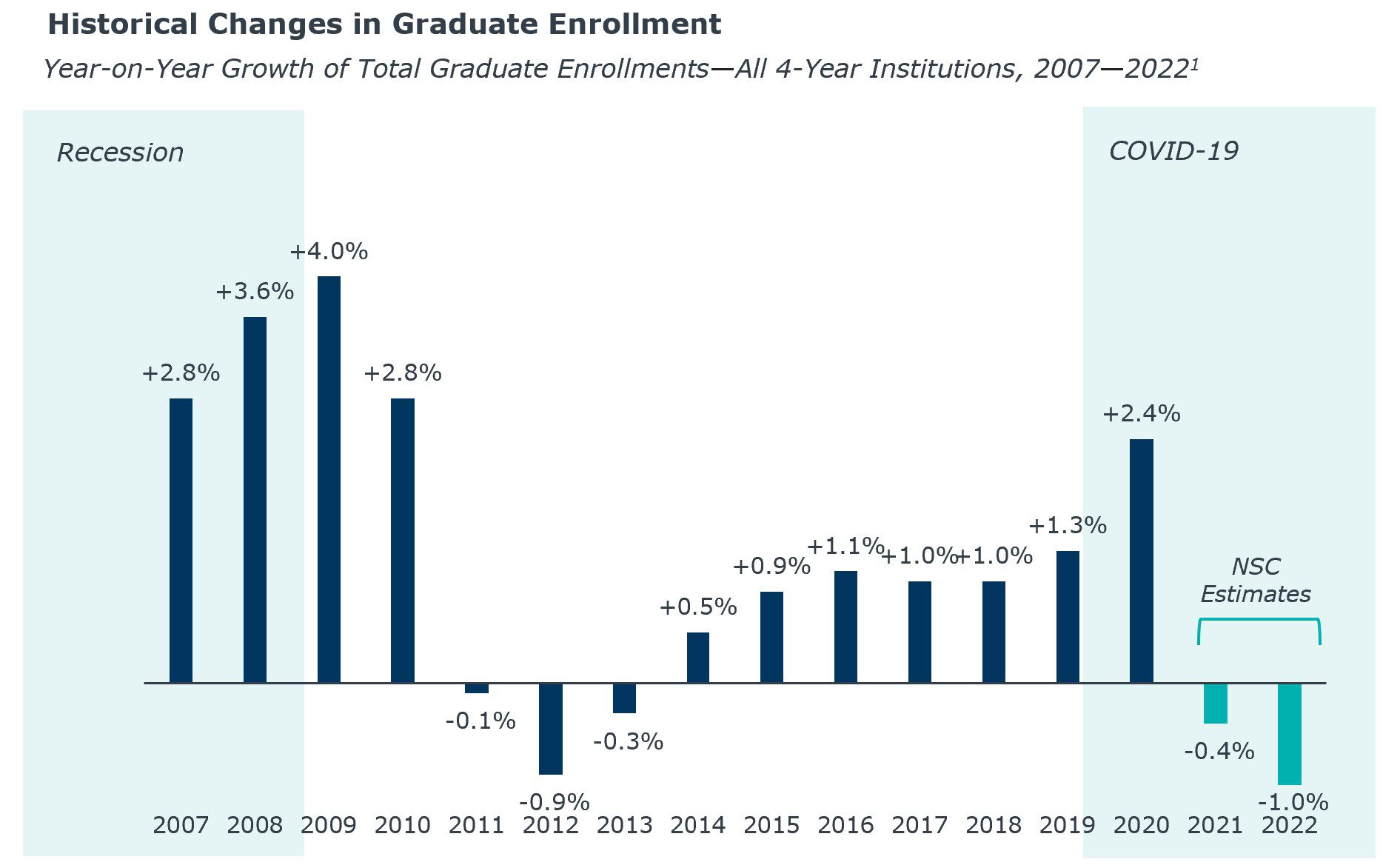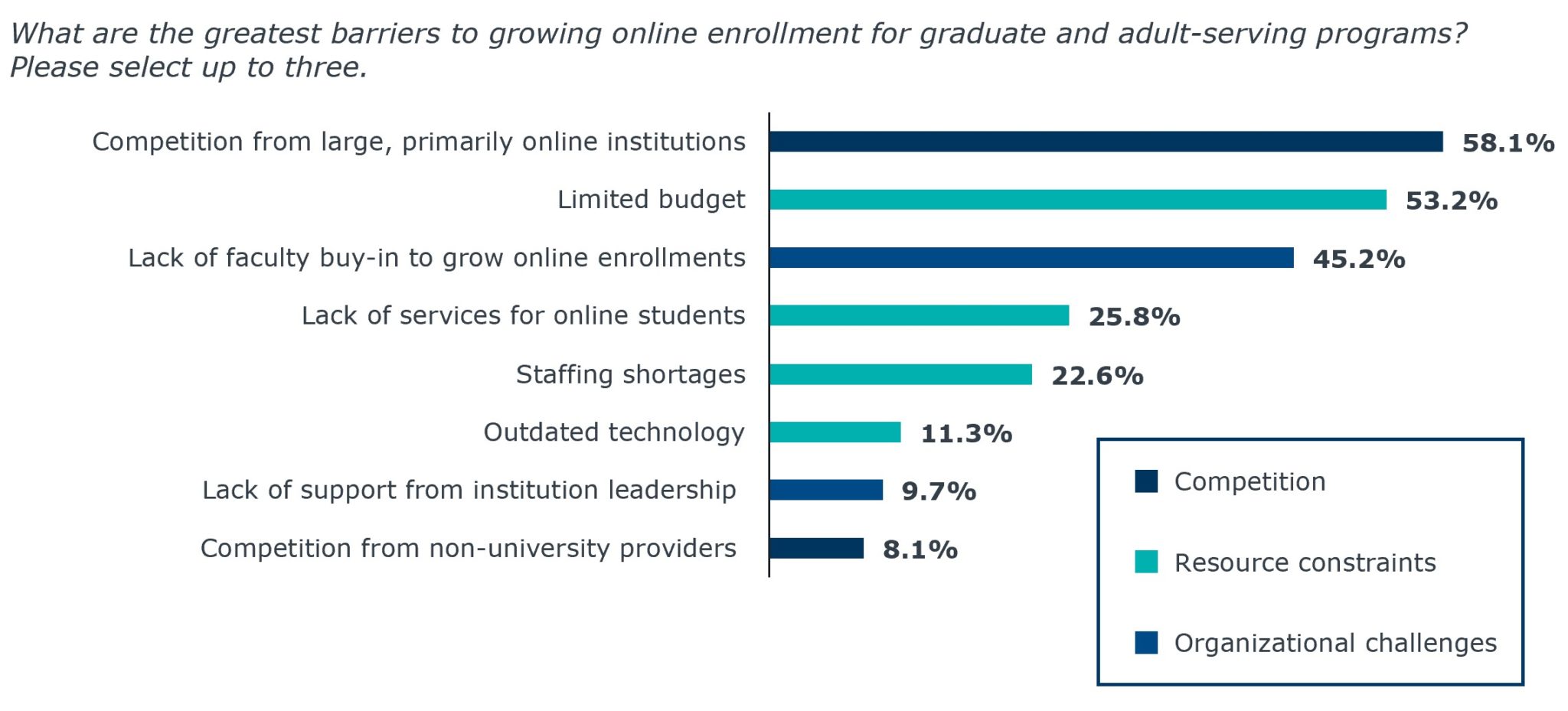The 3 big bets university presidents and provosts are placing on graduate and adult learner enrollments
Although there have long been peaks and valleys in graduate enrollment year over year, total graduate enrollment has increased across the last decade. An unfavorable labor market, the rise of distance education, and, of course, a global pandemic, spurred much of this growth. Now, for the first since 2013, graduate enrollment has declined, according to National Student Clearinghouse projections.

Despite these fluctuations, one thing remains evident: university leaders are prioritizing graduate and adult-serving programs and enrollment. In our new survey, 100% of university presidents and provosts identified grad and adult learner enrollment as a high or moderate priority.

Survey Methodology
EAB’s Adult Learner Recruitment and University Research teams surveyed 64 university executives, including presidents, provosts, vice provosts, and vice presidents of enrollment management, in summer 2022. Fifty-seven percent of respondents work at private, not-for-profit institutions, while 43 percent work at public, not-for-profit institutions.
University leaders are increasing enrollment goals
As institutions increasingly rely on net tuition revenue from graduate and adult-serving programs, enrollment goals for these programs are increasing. More than half of survey respondents said enrollment targets for their graduate and adult-serving programs have increased since the start of the pandemic. But our Adult Learner Recruitment experts regularly hear from university leaders just how challenging it can be to set enrollment goals that are realistic and generate sufficient NTR. Forty-one percent of survey respondents identified “setting realistic enrollment goals” as their top operational challenge during the COVID-19 pandemic.
EXPLORE THIS STEP-BY-STEP GUIDE FOR SETTING ENROLLMENT GOALS
Although enrollment goals are growing, resources to support these goals are not necessarily increasing in tandem. Here’s how the budget and staff allocated to graduate and adult-serving programs has changed—or hasn’t changed—at respondents’ institutions.
-
51%
of respondents said enrollment goals for their graduate and adult programs have increased since the start of the pandemic.
Institutions are placing big bets on allied health, business, and nursing programs
Most survey respondents are expanding their graduate and adult education portfolios to meet these growing enrollment goals. Fifty-six percent of survey respondents told us they increased their grad and adult ed offerings in the last three years. And nearly half of respondents said that launching new programs remains a top priority.
So what programs are presidents, provosts, and VPEMs betting on? We asked survey respondents to identify the three program areas they believe have the greatest growth potential. The most common answers include:
DOWNLOAD THE FULL SURVEY FINDINGS TO SEE OTHER DISCIPLINES UNIVERSITY LEADERS ARE PRIORITIZING
Respondents are doubling down on the online opportunity
Currently, 52% of survey respondents offer fewer than half of their graduate and adult-serving programs online. But the ongoing perception of online programs as a panacea to enrollment challenges has placed more pressure on graduate and adult-serving units to expand online offerings.
Students are also expressing more interest in online programs than they were pre-pandemic. In our survey of 2,000+ prospective graduate and adult learners, 46% said they were more likely to consider online programs as a result of experiences with (often emergency) online instruction during the height of the COVID-19 pandemic. It comes as no surprise then that 42% of surveyed university leaders identified expanding online programs and enrollment as a high priority; an additional 40% identify growing online as a moderate priority.
-
82%
of respondents said expanding online enrollment and/or offerings is a high or moderate priority for their institution.
But growing online is not without its challenges. About 60% of university leaders surveyed identified competition from large, primarily online institutions as a top barrier to expanding online enrollment. Survey respondents also pointed to limited budget and lack of faculty buy-in as challenges to growing online enrollment.

Notably, survey respondents are less keen to prioritize hybrid/low-residency programs than fully online offerings. Only 16% of surveyed university leaders identified expanding hybrid and/or low-residency options as a high priority for their institution.
As the graduate market moves away from its COVID-induced bumps in enrollment, and as undergraduate enrollment continues to fall short, university executives are facing more pressure to grow graduate enrollment. Creating a robust enrollment management plan—and putting the right programs, right lead gen strategy, and right marketing practices in place—will make all the difference in an institution’s ability to meet their (growing) grad and adult learner enrollment goals.

More Blogs

4 questions domestic students will ask before applying to your graduate program

When Grad PLUS disappears: What 8,000+ grad students said about paying for school
